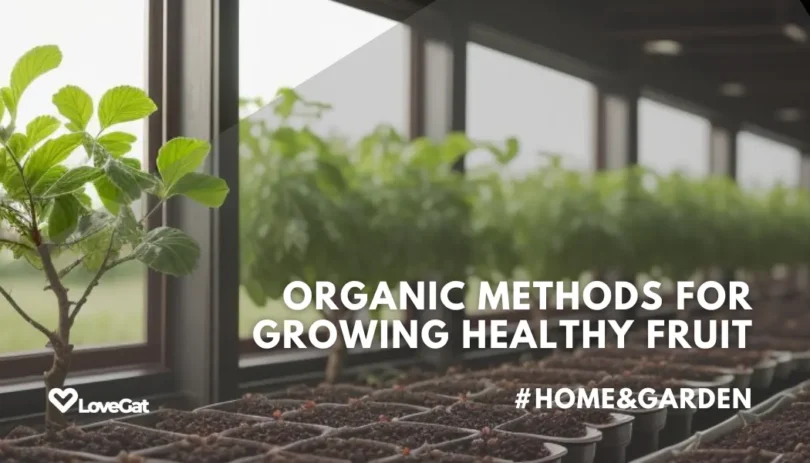Techniques for Growing Healthy Fruits Using Organic Methods!
Growing fruits organically is not only beneficial for your health and the environment but also ensures that you’ll enjoy delicious, nutritious produce free from harmful chemicals. Organic fruit gardening involves cultivating plants using natural methods and materials without synthetic fertilizers, pesticides, or herbicides. By following organic techniques, you can promote soil health, biodiversity, and the overall well-being of your fruit plants. Here are some effective techniques for growing healthy fruits using organic methods:
1. Soil Health and Fertility
Compost and Organic Matter
-
Compost: Create nutrient-rich compost from kitchen scraps, yard waste, and organic matter to improve soil structure and fertility. Incorporate compost into the soil before planting and use it as a top dressing throughout the growing season.
-
Mulch: Apply organic mulch, such as straw, leaves, or wood chips, around fruit plants to suppress weeds, retain moisture, and add organic matter to the soil as it breaks down.
Crop Rotation
- Rotate Crops: Implement crop rotation to prevent soil exhaustion and reduce the risk of pest and disease buildup. Rotate fruit-bearing plants with varying nutrient requirements to sustain soil equilibrium and vitality.
2. Pest and Disease Management
Beneficial Insects
-
Attract Beneficial Insects: Plant flowers and herbs that attract beneficial insects, such as ladybugs, lacewings, and parasitic wasps, which help control pest populations naturally.
-
Beneficial Plants: Integrate companion plants that repel pests or attract beneficial insects, such as marigolds, nasturtiums, and dill, to support a diverse ecosystem in the garden.
Natural Predators
-
Encourage Predators: Provide habitat for natural predators, such as birds, frogs, and predatory insects, by incorporating native plants, birdhouses, and water features into your garden design.
-
Handpicking: Monitor fruit plants regularly for signs of pests and remove them by hand if detected. Encourage children to participate in pest control by turning it into a fun and educational activity.
Disease Prevention
-
Good Air Circulation: Prune fruit plants regularly to promote good air circulation and reduce the risk of fungal diseases, such as powdery mildew and black spot.
-
Sanitation: Remove and dispose of diseased or infested plant material promptly to prevent the spread of pathogens. Clean pruning tools between cuts to avoid transmitting diseases.
3. Water Management
Drip Irrigation
-
Drip Irrigation: Install drip irrigation systems to deliver water directly to the root zone of fruit plants, minimizing water waste and reducing the risk of foliar diseases caused by overhead watering.
-
Watering Schedule: Water fruit plants deeply and infrequently to encourage deep root growth and drought tolerance. Water early in the morning to minimize evaporation and reduce fungal issues.
Rainwater Harvesting
-
Rain Barrels: Collect rainwater in barrels or cisterns for irrigation during dry periods. Rainwater is free from chlorine and other chemicals found in tap water, making it ideal for watering fruit plants.
-
Reuse Graywater: Reuse graywater from household activities, such as dishwashing or showering, to irrigate fruit plants. Use eco-friendly soaps and detergents to minimize chemical residues.
4. Organic Fertilization
Natural Amendments
-
Organic Fertilizers: Use natural fertilizers, such as compost, aged manure, bone meal, and seaweed extract, to provide essential nutrients to fruit plants without synthetic chemicals.
-
Cover Crops: Plant cover crops, such as clover or legumes, to enrich the soil with nitrogen and other nutrients through natural processes of nitrogen fixation and decomposition.
Foliar Feeding
-
Foliar Sprays: Apply organic foliar sprays, such as compost tea or seaweed extract, to fruit plants to provide a quick boost of nutrients and enhance overall plant health.
-
Liquid Nutrients: Mix liquid fish emulsion or fish hydrolysate with water and spray it directly onto the foliage of fruit plants to supplement their nutrient uptake and promote vigorous growth.
By implementing these organic gardening techniques, you can cultivate healthy fruit plants that thrive in a sustainable and environmentally friendly manner. Focus on building soil health, promoting biodiversity, managing pests and diseases naturally, and conserving water resources to create a resilient and productive fruit garden. With dedication, patience, and a commitment to organic principles, you’ll enjoy a bountiful harvest of delicious, nutritious fruits straight from your own garden. Happy organic gardening!
You Might Also Like
- How I used AI to create a living data visualization for our home
- 20 Cool Home Decor And Designs For Any Style
- Planning a garden? Here’s a step-by-step guide to start off on the right foot
Social Media Communities
Share your digital nomad experiences and connect with fellow Us:
- Instagram: @Lovegatofficial
- Facebook: @LoveGat
Your journey doesn’t end here. Continue to explore and share our Decor & Home Posts.







